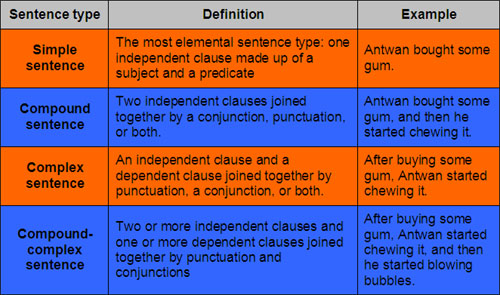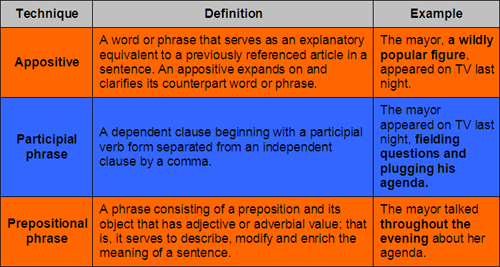 username@email.com
username@email.com
In this lesson, you will learn about sentence mechanics, sentence variety, and word choice.
If the paragraph is the building block of writing, then the sentence is its atomic unit. Good composition starts with good sentences. Well-written prose employs a variety of sentence structures and constructions while avoiding syntactic missteps.
Sentences 101
Before we delve into the discussion of the importance of varied sentence structure, a brief review of the basics of sentence writing is in order.
Sentences are made up two kinds of clauses:
In the sentence “The video store was closed because of the holiday,” “The video store was closed” is an independent clause, while “because of the holiday” is a dependent clause.
These two types of clauses are combined in various ways to produce the four basic sentence types.

The Importance of Sentence Variety
It’s important to intersperse each of those types of sentence throughout your writing. An essay composed entirely of simple sentences would be choppy and simplistic, while an essay made up exclusively of compound-complex sentences would be verbose and overly dense. Mixing up your constructions will enhance the flow, rhythm, interest, and continuity of your writing.
You can place a short simple sentence after a string of longer sentences to emphasize and call attention to the content of the shorter sentence. Longer, more complicated sentence structures are better suited to explaining difficult concepts.
In particular, the structure of a compound-complex sentence naturally lends itself to explaining the coordination and subordination of related ideas. By expressing the most important ideas in independent clauses and the subordinate ideas in dependent clauses, a writer can use sentence structure to mirror and reinforce conceptual relationships.
You can add sentence variety to your writing by combining short, related sentences into a single longer one.

Parallel Structure
A particular sentence construction you should look to incorporate into your writing is parallel structure. Parallel structure is a sentence structure that employs consistent construction in relation to all of its verbs, subjects, and objects.
A telltale sign that a sentence employs parallel structure is that the verb phrases or subjects could switch places in the sentence without creating any grammatical errors. For example, the following sentences exhibit parallel structure:
While this sentence employs a faulty and inconsistent construction:
The precision of parallel structure adds clarity to your writing. It also enhances your writing’s readability by maintaining a natural cadence to your language.
Sentence variety is important, but grammatical accuracy is equally important. As you work to incorporate novel constructions into your writing, be sure to avoid these common pitfalls.

Which one of the following sentences employs an erroneous construction?
One of the most common and easily avoidable mistakes in sentence writing is overuse of sentences written in passive voice. Passive voice describes a sentence construction in which the subject of the sentence is the receiver or object of the verb’s action.
Visitors were received by the President.
The milk and cookies were enjoyed by the children.
The flyer was posted to the bulletin board.
The package was not received.
You can identify sentences written in passive voice because they:
Use a “to be” verb (am, is, are, was, were, be, been, being)
Closely follow the “to be” verb with a preposition (by, from, to, etc.)
Active voice describes a sentence construction in which the subject’s sentence performs or undertakes the verb’s action. Whenever possible, it is better to write using active voice than passive voice. Active voice enlivens writing, quickens its pace, and improves word economy.
Sometimes you can convert a sentence written in passive voice to active voice simply by rearranging its components:
The president received visitors.
The children enjoyed the milk and cookies.
Other times you’ll have to specify a previously unnamed subject or object, which requires greater modification:
Someone posted the flyer to the bulletin board.
I did not receive your package.
This is not to say that it’s never appropriate to write in the passive voice. Scientific writing, for example, often employs passive voice to foster a detached, objective tone. Passive voice is also appropriate in sentences that seek to direct attention toward their objects:
Side effects such as nausea and headaches were observed.
The painting was stolen from the museum.
However, those situations are rare. As rule of thumb, consistent use of active voice makes for stronger writing.
Even the most well-constructed sentences will seem awkward and out of place if they are constructed using words and phrases that are not germane to the topic at hand and consistent with the paper’s purpose.
Some rules of vocabulary and word choice are virtually universal:
However, other idiosyncratic factors also influence word choice. Specifically, an essay’s purpose and the writer’s voice both should influence the vocabulary of a piece of writing. Because those factors vary from essay to essay, there are no hard and fast rules that dictate which word choices are prudent and which ones are not.
Specialized vocabulary and highly technical terminology would be appropriate in an article in a trade publication, for example, but not in an expository essay targeted toward neophytes. Including colloquialisms and slang might be crucial to the believability of some narratives but antithetical to the aims of a literary analysis.
As you select words and phrases to incorporate into your writing, keep the following questions in mind. Their answers should strongly influence your writing’s vocabulary: